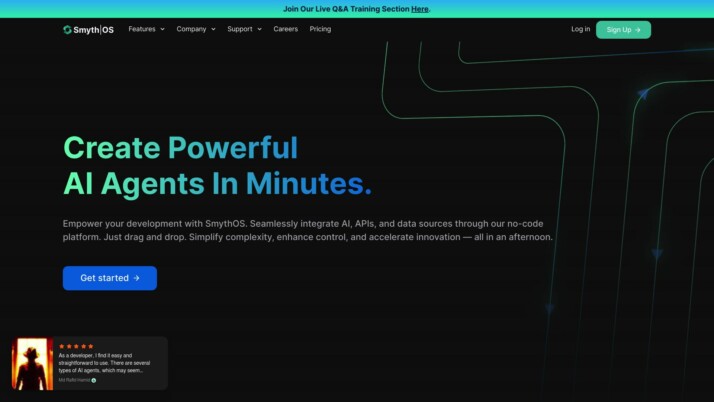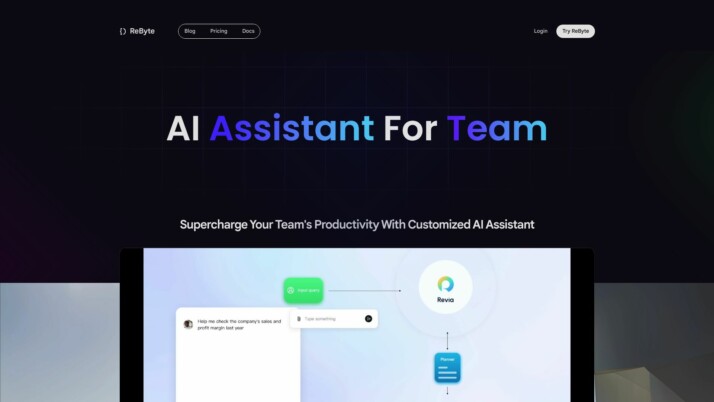SmythOS vs. Rebyte: Comprehensive Feature Comparison
In today’s fast-paced, ever-changing world of artificial intelligence (AI), the demand for powerful yet accessible solutions to harness the potential of this revolutionary technology is at an all-time high. As we explore the feature sets and capabilities of two prominent AI platforms, SmythOS vs. Rebyte, it becomes evident that both offer unique strengths and cater to diverse user needs.
This comprehensive comparison will guide readers through the intricacies of each platform, empowering them to make informed decisions that align with their specific goals and requirements.
SmythOS Overview
SmythOS is a groundbreaking platform that revolutionizes the creation and deployment of AI agents. As a versatile AI operating system, it empowers users to build, manage, and orchestrate intelligent agents with remarkable speed and efficiency.
SmythOS stands out with its intuitive drag-and-drop interface, enabling even those with minimal coding experience to construct complex AI workflows seamlessly. This democratizes AI development, making advanced capabilities accessible to a broader audience.
SmythOS offers pre-built templates and API integrations, significantly reducing setup time and allowing users to focus on innovation.
One of SmythOS’ key strengths lies in its extensive integration ecosystem. The platform supports a vast array of APIs, AI models from providers like OpenAI, Anthropic, and Hugging Face, as well as tools like Slack, Trello, GitHub, and Stripe. This flexibility ensures that SmythOS can seamlessly integrate into virtually any workflow or business process.


Notably, SmythOS offers pre-built AI templates and API integrations, significantly reducing setup time and allowing users to focus on innovation. Furthermore, the platform supports multi-agent orchestration, enabling teams of AI agents to collaborate on complex tasks, enhancing efficiency and scalability.
With SmythOS, we have shipped a comprehensive AI operating system that empowers users to create, deploy, and manage AI agents with unparalleled ease. Our vision is to revolutionize the way businesses and individuals utilize AI, enabling them to automate mundane tasks, improve efficiency, and drive innovation at unprecedented levels. By making AI agent creation and deployment 99% faster and more accessible, we aim to unleash an economic revolution where AI transforms workflows and drives advancements across various industries.
Rebyte Overview
Rebyte is an open-source platform designed to enable anyone to develop AI-powered applications quickly and efficiently, even without extensive coding skills. At its core, Rebyte offers a visual agent builder that allows users to create highly customizable AI agents with multiple steps using large language models. This visual interface simplifies the process of constructing complex backend logic for AI applications.
One of Rebyte’s key strengths lies in its ability to create fully customized user interfaces for agents without requiring any coding. This no-code approach empowers users to build engaging and intuitive AI experiences tailored to their specific needs. The platform also offers seamless integrations with private data sources, enabling users to leverage their existing data to train and deploy AI agents.


Beyond its user-friendly interface, Rebyte provides detailed observability into every step of an agent’s execution, allowing for effective debugging and refinement. Additionally, the platform offers a serverless runtime designed for production deployment and effortless scaling of AI agents, ensuring that applications can handle increasing demands without compromising performance.
With Rebyte, users can go from idea to deployment with minimal manual coding required. The platform aims to democratize AI development, empowering knowledge workers and teams to automate workflows and boost productivity through intuitive, no-code interfaces. Rebyte’s vision is to usher in a GenAI era
where anyone can create and deploy AI-powered applications simply by describing their desired functionality.
Feature Comparison
When comparing the dissimilar features between SmythOS and Rebyte, SmythOS emerges as the more comprehensive and feature-rich platform. Rebyte lacks several key capabilities that SmythOS boasts, such as support for autonomous agents, multimodal interactions, multi-agent collaboration, and advanced security features like constrained alignment, data encryption, and OAuth integration.
SmythOS provides more flexible deployment options, allowing users to deploy agents as webhooks, on staging domains, and as scheduled agents.
Furthermore, SmythOS offers a broader range of components, including integration with Hugging Face models, classifiers, logic components, and support for data lakes. This extensive set of tools empowers users to build more sophisticated and adaptable AI agents tailored to their specific needs.
Notably, SmythOS provides more flexible deployment options, allowing users to deploy agents as webhooks, on staging domains, and as scheduled agents. It also supports API authentication with OAuth and API keys, ensuring robust security for production deployments. In contrast, Rebyte’s deployment options are more limited, lacking features like webhook deployment, staging domains, and scheduled agent deployment.
Feature Comparison Table
| SmythOS | Rebyte | |
|---|---|---|
| CORE FEATURES | ||
| Autonomous Agents | ✅ | ❌ |
| Multimodal | ✅ | ❌ |
| Multi-Agent Collaboration | ✅ | ❌ |
| SECURITY | ||
| Constrained Alignment | ✅ | ❌ |
| Data Encryption | ✅ | ❌ |
| OAuth | ✅ | ❌ |
| IP Control | ✅ | ❌ |
| COMPONENTS | ||
| Huggingface AIs | ✅ | ❌ |
| Classifiers | ✅ | ❌ |
| Logic | ✅ | ❌ |
| Data Lakes | ✅ | ❌ |
| DEPLOYMENT OPTIONS | ||
| Deploy as Webhook | ✅ | ❌ |
| Staging Domains | ✅ | ❌ |
| Production Domains | ✅ | ❌ |
| API Authentication (OAuth + Key) | ✅ | ❌ |
| DATA LAKE SUPPORT | ||
| Sitemap Crawler | ✅ | ❌ |
| YouTube Transcript Crawler | ✅ | ❌ |
| URL Crawler | ✅ | ❌ |
Conclusion
In the ever-evolving landscape of AI technology, SmythOS stands out as a remarkable platform that empowers users to harness the full potential of AI agents. With its intuitive drag-and-drop interface, extensive integration ecosystem, and versatile deployment options, SmythOS streamlines the creation and deployment of AI solutions, making them accessible to a broad range of users.
By supporting a vast array of AI models, APIs, and tools, SmythOS enables seamless integration into virtually any workflow or business process. Its pre-built templates and components significantly accelerate development, allowing users to focus on innovation and exploring the boundless possibilities of AI.
SmythOS’ multi-agent orchestration capabilities further amplify the power of AI, enabling teams of agents to collaborate on complex tasks, driving efficiency and scalability to new heights. As we continue to explore the frontiers of AI, platforms like SmythOS will play a pivotal role in democratizing AI development and empowering businesses and individuals to unlock the true potential of this transformative technology.
To experience the future of AI agent creation and deployment, visit our website at SmythOS and explore the comprehensive suite of tools and resources we offer.
Embark on a journey of innovation and discover how SmythOS can revolutionize your workflows and drive your organization towards unprecedented success. Get started with your free account today and witness firsthand the power of SmythOS in action. Don’t miss this opportunity to be at the forefront of the AI revolution!
Last updated:
Disclaimer: The information presented in this article is for general informational purposes only and is provided as is. While we strive to keep the content up-to-date and accurate, we make no representations or warranties of any kind, express or implied, about the completeness, accuracy, reliability, suitability, or availability of the information contained in this article.
Any reliance you place on such information is strictly at your own risk. We reserve the right to make additions, deletions, or modifications to the contents of this article at any time without prior notice.
In no event will we be liable for any loss or damage including without limitation, indirect or consequential loss or damage, or any loss or damage whatsoever arising from loss of data, profits, or any other loss not specified herein arising out of, or in connection with, the use of this article.
Despite our best efforts, this article may contain oversights, errors, or omissions. If you notice any inaccuracies or have concerns about the content, please report them through our content feedback form. Your input helps us maintain the quality and reliability of our information.
